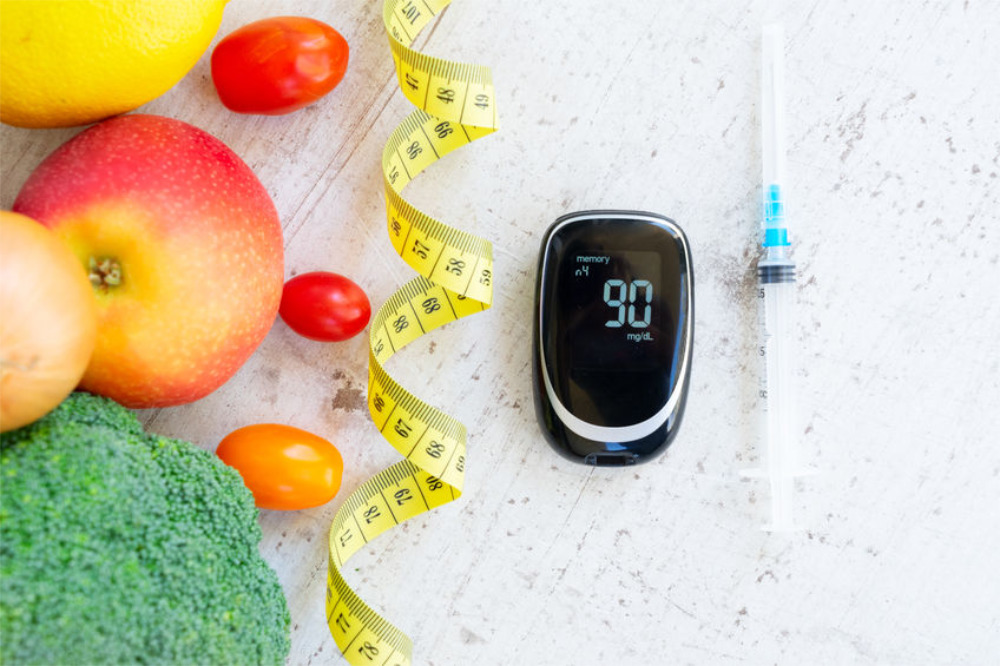Insulin plays a fundamental role in how food is utilised and stored. A state of insulin resistance results in metabolic dysregulation, subsequent health issues and chronic diseases, such as type 2 diabetes. Read on to find out more about insulin, insulin resistance, type 2 diabetes and how they are related to one another.
What is insulin?
Insulin is a chemical messenger, a hormone, secreted into the bloodstream due to the presence of food in the body. It is secreted from the beta cells of the pancreas. The greatest insulin response occurs from the macronutrient carbohydrate – high levels of which are found in foods like bread, pasta, potatoes, biscuits, cakes and fruits.
Digested food is broken down into sugar (glucose) in the bloodstream and a major role of insulin is to facilitate moving this glucose from the bloodstream into the cells so it can ultimately be used to make energy and fuel us.
Another major role of insulin is to promote the storage of fat and making of new fat from glucose. It also has other important roles, such as stimulating the processes of growth (cell replication) and preventing the breakdown of old cells (autophagy), this is one reason why strict management of insulin has been an area of interest in the treatment of cancers – this is out of the scope of this article.
What is insulin resistance?
Insulin resistance is when certain cells becoming increasingly resistant to the effects of insulin.
Blood glucose levels need to be kept within strict parameters. Therefore, over a period of time, insulin resistance results in the pancreas secreting increasingly greater amounts of insulin in order to maintain normal levels of blood glucose. (1).
Although genetics may play a role in the level of insulin resistance an individual has, lifestyle factors, particularly poor diet, stress management, sleep and inadequate physical activity play a considerable role in how insulin resistant an individual becomes (2). In particular, consumption of refined carbohydrates, a proinflammatory diet, continually eating, reduced physical activity and insufficient and disrupted sleep cycles all play a role in the development of insulin resistance (2).
Type 2 diabetes
Type 2 diabetes, known as non-insulin-dependent diabetes, is due to the impaired secretion of insulin by dysfunctional beta cells in the pancreas usually in combination with insulin resistance (3).
Functioning beta cells are required for adequate insulin secretion and therefore to maintain normal blood glucose levels. When beta cells become dysfunctional, there is inadequate insulin secretion to manage blood glucose levels and this is described as type 2 diabetes. Although insulin resistance is a common part of type 2 diabetes, it is not always the case. The dysfunction of the beta cells and insulin secretion determines type 2 diabetes (4).
Initially, insulin resistance it is managed by a greater secretion of insulin to achieve normal blood glucose levels. However, over time glucose levels can begin to change as the body struggles to manage blood glucose purely from increase secretion of insulin. These initial changes are known as prediabetes. Prediabetes is reflected by impaired fasting glucose (IFG) and impaired glucose tolerance (IGT) levels (5). This means that your fasting glucose will be elevated out of normal ranges and how you manage increases in blood glucose is limited, meaning that after eating blood glucose peaks higher and takes longer to return to normal levels.
If prediabetes is not treated, it can further progression to type 2 diabetes, characterised by high levels of blood glucose, known as hyperglycaemia. Type 2 diabetes is not necessarily clear to diagnose, and many people may not have any obvious symptoms, however here are some symptoms to look out for when glucose levels are higher or become harder to manage.
- Craving sugar, especially after meals or even after eating other sugary foods
- Frequent urination
- Excessive fat around the mid-section or a waist bigger than your hips
- Feeling fatigued after meals
- Excessive thirst
Stages of type 2 diabetes: (6)
1. Insulin resistance
Due to a combination of genetic and lifestyle factors. Lifestyle changes from diet, physical activity and weight loss can prevent and reverse insulin resistance and prevent and delay further progression.
2. Prediabetes
Characterised by abnormal glucose regulation. Early screening and prevention strategies such as weight loss and enhanced physical fitness can prevent further progression to type 2 diabetes, as well as reversing prediabetes.
3. Type 2 diabetes
The beta cells that secrete insulin become dysfunctional and the disease is characterised by chronic hyperglycaemia. Intensive lifestyle interventions of diet, physical activity and weight loss can reverse type 2 diabetes as well as improving it and delaying complications.
4. Blockages of the arteries /circulatory problems
Progression of the disease due to chronic hyperglycaemia results in vascular complications. An example is heart disease. The extent of complications is dependent upon the duration of disease, blood glucose levels and other risk factors. Later stages can lead to neuropathy and complications such as the loss of limbs. Even at this stage, things can still be improved through nutrition and lifestyle intervention strategies alongside conventional treatment.
Type 2 diabetes screening / diagnosis
The presentation of symptoms and disease progression can vary considerably, with some people not showing any symptoms. Screening tests include risk assessment questionnaires, biochemical tests and combinations of the two. Biochemical tests include blood glucose/urine glucose measurements, blood HbA1c or blood fructosamine measurements. There are pre-determined cut-off points that defines the ‘high risk’. Screening tests are followed by diagnostic tests – fasting blood glucose and/or an oral glucose tolerance test (7).
The most common marker for diagnosis type 2 diabetes is the HbA1c marker. This marker looks at average levels of blood glucose over a period of a few months. Like many tests, it is not perfect and in instances of anaemia this can skew the results and lead to improper diagnosis of type 2 diabetes. Therefore, if you have been diagnosed with type 2 diabetes based upon your HbA1c scores alone, you must also run a haematology screen to ensure that you are not anaemic to ensure it is an accurate diagnosis.
Prevention / delaying onset of type 2 diabetes
Type 2 diabetes can be prevented, treated or delayed through lifestyle changes, or medication.
Lifestyle intervention is shown to have the greatest impact in reducing the occurrence of type 2 diabetes, as well as significantly reducing other common health risks, such as cardiovascular disease. It also has a favourable safety profile (5).
Insulin resistance and type 2 diabetes
Most people with type 2 diabetes develop insulin resistance 1-2 decades before the onset (3). Insulin resistance in the children of parents with type 2 diabetes is the best predictor for later development of the disease (8). Reductions in insulin resistance may prevent the development of diabetes or delay disease progression (9). Insulin resistance, high levels of insulin and hyperglycaemia exacerbate one another and contribute to the poor functioning of the beta cells in the pancreas that determine type 2 diabetes (10).
Contributing factors for type 2 diabetes:
Type 2 diabetes results from genetic and lifestyle factors.
Age
Aging is associated with increased risk for type 2 diabetes, due to decreased cellular health and function, increased insulin resistance and reduced functional beta cells (11).
Genes
Genes affect beta cell function either directly or indirectly via insulin resistance. The Pima Indian race have a strong genetic predisposition for type 2 diabetes (12).
Insulin resistance
Insulin resistance results in increased demands for insulin secretion from the beta cells. This develops into a stress, damaging beta cells and causing dysfunction (10). Factors that contribute to insulin resistance also contribute to beta cell failure, for example the toxic effects of both fatty acids and hyperglycaemia cause insulin resistance and beta cell dysfunction.
Lifestyle factors
The major ones are excess weight, poor diet and low physical activity. However, other factors such as stress, sleep and smoking all affect the development of type 2 diabetes. In the article ‘Lifestyle factors and type 2 diabetes’ I discuss this in more detail.
Inflammation
Lifestyle factors can contribute to an inflammatory response causing insulin resistance and beta cell dysfunction. Check out the article ‘Inflammation and type 2 diabetes’ to learn more.
Infections
There are associations with hepatitis C virus, which may lead to insulin resistance and type 2 diabetes (12). Infections in general cause a temporary more insulin resistant state, hence fasting glucose and glucose tolerance during a time of infection may be skewed.
Take away message
Insulin determines the fate of the food we eat: it plays a key role in facilitating whether glucose enters the cells or stays in the bloodstream and it plays a key role in the storage and making of fat.
Insulin resistance is when a group of cells becoming increasingly resistant to the effects of insulin. it results in high levels of glucose in the blood stream and high levels of insulin. High levels of insulin mean that fat is readily stored. Also, high levels of insulin are associated with a state of ill health and chronic diseases such as type 2 diabetes. Insulin resistance is most effectively improved through increasing physical activity, exercise, losing weight and improving diet.
Type 2 diabetes results from genetic and lifestyle factors: and is most effectively reversed, prevented and delayed by changing dietary habits, increasing physical activity levels and losing excess weight. The earlier you start implementing healthy daily habits, the better. However, it’s never too late. What step will you take today?
If you enjoyed this, you may enjoy some of the following related articles:
- Lifestyle factors and type 2 diabetes
- Inflammation and type 2 diabetes
- 10 tips to improve insulin sensitivity
- Improve insulin sensitivity with these exercise tips
Contact Steve Grant Health
To learn more out how Steve Grant Health can assist you on your journey, please fill out the enquiry form below.
If you have been referred by a clinician, please complete the form and ensure that you state who has referred you or have your practitioner email Steve direct to make a referral that way.
Click the button below to open the client enquiry form:
[widgetkit id=”643″]
References
- Shanki et al. (2008). Insulin resistance and hyperinsulinemia. Is hyperinsulinemia the cart or the horse?
- Fung et al. (2016). Hyperinsulinemia and insulin resistance: scope of the problem.
- Defronzo et al. (1992). Pathogenesis of NIDDM. A balance overview.
- DeFronzo (2009). From the triumvirate to the ominous octet: a new paradigm for the treatment of type 2 diabetes mellitus.
- Nathan et al. (2007). Impaired fasting glucose and impaired glucose tolerance.
- Mechanick et al. (2018). Dysglycaemia-based chronic disease: an American association of clinical endocrinologists position statement.
- World Health Organisation (2012). Screening for type 2 diabetes.
- Warram et al. (1990). Slow glucose removal rate and hyperinsulinemia precede the development of T2DM in the offspring of diabetic parents.
- Azzen et al. (1998). TRIPOD: a randomised, placebo controlled trial of troglitazone in women with prior gestational diabetes mellitus
- Cerf (2013). Beta cell dysfunction and insulin resistance
- Ling (2009). Epigenetics: a molecular link between environmental factors and type 2 diabetes.
- Kolb (2017). Environmental/lifestyle factors in the pathogenesis and prevention of type 2 diabetes


